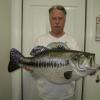I often remember the In-Fisherman Master Angler chart, which is really a latitude equivalency chart, when it comes to LMBs. On that chart, a 6.5-pound Northern Strain LMB is equivalent to a 10-pound Southern LMB. For an Ontarian like you, I'd stretch the difference a little more and suggest that a 6-pounder in Kingston would be equivalent to a 10-pounder in Orlando, a 10.5-pounder in the Everglades, and perhaps an 11-pounder in Lake Baccarac, as you have serious winters.
I'm actually a little bit north of you, so I'd apply the same equivalencies to my bass, as I've a moderating ocean. You, of course, have Lake Ontario, which would also moderate your lows, but our bass still go through low metabolism stretches that last for months where they're barely feeding and growing. Of course, genetics also prevent northern bass from peaking much beyond ten pounds.
What's interesting about the chart is that there is no difference between southern and northern smallmouth. A six-pounder caught in the north equals a six-pounder caught in the south. They're equally rare.
In the last three years, I've caught multiple 6+-pounders and especially in 2023 when I focused on the bogs. Here are some of them, all weighed or measured. Note that they're bass with bellies, except for the first one, and all have hunchbacks. For comparison, the first bass, which is the skinny one, weighed 6.54-pounds. The third and fourth fish are silly fat. I caught another two that were six and three-quarters in 2023 and a bass in 2024 that was longer and fatter than any of these, but 2024 has been more about quantity than quality simply because the quantity ponds are easier to reach, which matters because I turn 68 this month*:
The quantity ponds are also great fun and full of four and five-pounders, like this gal caught this week:

.thumb.jpg.d431b5daa6ef35470410602b9be6f3ae.jpg)

